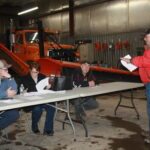When Verna Murphy was born in 1910 her father listed his occupation as “laborer.” When Benjamin Worster died in 1953 his death certificate records that his occupation was “woods laborer.” When Thomas McGinley married Effie Bailey in 1916, Thomas’ occupation was given as “common laborer.”
These men all represented one of the most prevalent occupations years ago. They were laborers and there were laborers everywhere and they played a critical role in our country’s economy.
When researching in the U.S. Census or in vital records you should record all information given including occupations. Don’t be surprised to find laborers among the most common listings. Laborers shouldn’t be regarded as a lowly way to make a living. Laborers were essential in keeping the industrial economy running in an age of pre-mechanization. Laborers were found in the operation of shipyards, cotton and woolen mills, factories of all stripes, breweries, mining, metal works, farms, and just about any other operation you can name.
Prior to the introduction of tools such as forklifts, laborers were valued for their strong backs and arms since it took sheer muscle to wrestle raw materials into a mill or factory and to haul the finished product out again. It took strong backs to unload cargoes from ships and trains and muscles to do all the toting, shifting, lugging, and pushing needed to keep factories operating. In short, the work they did was physical and important. Even after so-called “labor-saving” tools appeared, many smaller factories didn’t have the capital to invest in automation so human laborers were still widely employed well into the twentieth century.
Some laborers were actually specialists. It isn’t unusual to find a laborer working in one factory or other operation all his life. Common laborers were “jacks of all trades” putting their hands and backs to whatever work was needed and would provide a paycheck. Sometimes they stayed in one area because there was always a need for their services. Others moved around looking for employment.
Genealogists can find tracking common laborers tricky. One tip is to follow the children. The birth records of the children of a laborer’s family will indicate where a family was living at the time of the child’s birth. It’s not at all unusual to find that siblings in a family all had different birthplaces as the family moved with Dad as he went where there was work.
Sometimes the position of laborer could lead to promotion or to a better trade. When Beverly Larson married John Lozier he was a laborer in a Brewer shipyard. In a few years the family was living in Portsmouth and he was working at the Portsmouth Naval Shipyard in Kittery having turned his skills into a higher paying position.
The occupation of laborer often runs in families, fathers, sons, and grandsons all giving their occupations as laborer. As you research don’t be surprised to find laborers in your tree. Whether specialized or common they were literally everywhere.
Columnist Nancy Battick of Dover-Foxcroft has researched genealogy for over 30 years. She is past president of the Maine Genealogical Society, author of several genealogical articles and co-transcribed the Vital Records of Dover-Foxcroft. Nancy holds an MA in History from UM and lives in DF with her husband, Jack, another avid genealogist. Reader emails are welcome at nbattick@roadrunner.com.







